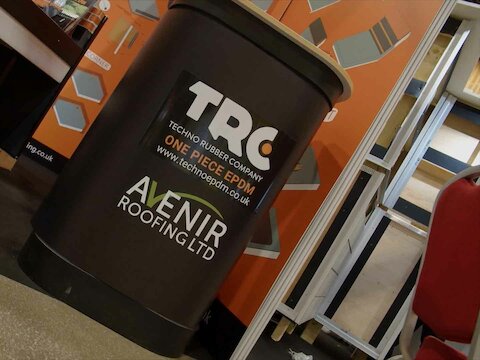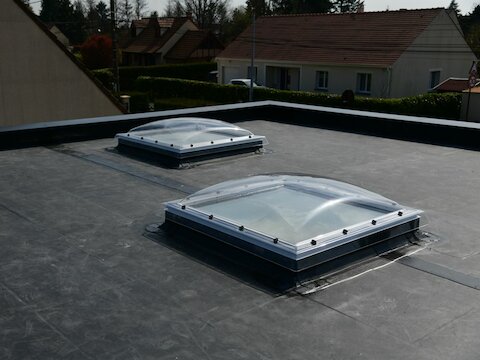Different Types of Flat Roofing & How They Compare
There are so many different types of flat roofing available, it can be hard to know which one is the most suitable for your roof. Although they all serve the same purpose, they are strikingly different. It is important to know what the pros and cons are of each one before you can make an informed decision.
To find out how each type of flat roof compares and which one we think reigns supreme, we’ve outlined the pros and cons of 3 flat roofing types below.
Felt Flat Roof
Torch-on felt roofing, sometimes known as torch-down roofing uses 3 layers of modified bitumen which is melt-welded onto the roof surface with a blowtorch. Felt roofing is a versatile option because it can be used on flat and pitched roofs. It is a traditional option and has been in the roofing industry for a long time.
Pros
- It’s strong
Although felt roofing is not considered the strongest of all the flat roof types, it can withstand the elements meaning that debris won’t break the surface. It will also resist tears and leaks to a high level.
- It’s inexpensive
An added benefit to this type of roofing is that it is inexpensive. You can buy rolls of felt roof for a fair price, although you must consider that felt roofs must be installed by a professional, which adds to the cost.
Cons
- It has a short lifespan
Felt roofs only tend to have a 15-20 year lifespan, which is much less than other flat roofing types. Some even say that felt roofs only last as long as 5-8 years.
- It must be professionally installed
This may not be a problem for people who always opt for professional installation. But, there are other types of flat roofs on the market which you can install yourself. Because of the dangers of using a blowtorch, you will not be able to install a flat roof without a professional.
- Repairs are untidy
If repairs have to be made to a felt roof, it is quite widely acknowledged that most repairs look untidy. When patchwork is carried out, felt roofs can end up looking scruffy and unsightly because of the nature of the material.
- It’s not as weatherproof as other flat roofing types
Although felt roofing has been recognised for its strength, there are roofing experts who suggest that it isn’t quite as weatherproof as other types of flat roofing. For example, extremely hot temperatures can cause the felt to crisp and the surface of the material is easily worn.
Built-Up (BUR) Flat Roof
This type of flat roofing is typically comprised of hot tar and gravel which is installed in layers. This is not the most common type of flat roofing and normally fares better in warmer climates.
Pros
- It’s aesthetically pleasing
The biggest advantage of built-up roofs, over its competitors, is that it looks great. Many people prefer the look of the top gravel layer over other flat roofing types.
- It’s resistant
Another positive for this type of roofing is that the gravel makes it extremely fire-retardant which can give you peace of mind. It is also UV resistant, making it tough in warm temperatures.
Cons
- It’s heavy
Something which makes this type of roofing unsuitable for many buildings is that is it extremely heavy. Due to the materials used, the buildings on which this is installed must be strengthened and reinforced so they can hold the weight.
- It’s messy
Because of the number of layers and the materials used, this type of flat roofing is messy to install. It certainly isn’t one of the easiest to handle and as a result of this, built-up roofs are not recommended for properties that are already occupied.
- It has a short lifespan
Similar to felt roofs, this roof is only made to last about 10-15 years and some say that built-up roofs can last up to 30 years. This may be a good thing, but it is important to consider other roofing options that are known to last even longer.
EPDM Rubber Roof
EPDM rubber roofing is becoming more and more popular over the years because of its wide range of benefits. It is made from an extremely strong rubber and can be installed easily in one sheet.
Pros
- It’s strong
EPDM rubber is renowned for its superior strength. It can withstand hot and cold temperatures and harsh weather conditions. It is also fire retardant. To find out more about how strong EPDM is, read our blog post that explains it all.
- It has a long life expectancy
Unlike other types of flat roofing, EPDM rubber has a life expectancy of up to fifty years. Some rubber roofs have been around for decades, so if you’re looking for the longest lasting solution, EPDM rubber may be the flat roof for you.
- It’s environmentally friendly
For those of you who like an environmentally friendly option, EPDM rubber is non-toxic and durable, resulting in less of a need for disposal. Plus, they are green-system compatible and have insulating properties which help people save energy in heating and cooling their property.
- It’s easily installed
EPDM is easily installed and can be done in one large sheet. Also, becoming a certified installer is easy, thanks to the effective one-day Firestone training courses offered at Avenir Roofing.
- It’s low maintenance
Another advantage of EPDM rubber is that it is low maintenance. The only maintenance that needs to be carried out for this roof is the general removal of debris and regular inspections. It protects against moss and other pesky plants, contributing to its low-maintenance reputation.
- It looks tidy
EPDM rubber looks neat and tidy on a variety of roofs. Because it is often installed in one sheet, you get a smooth and sleek finish.
Cons
- Damage can happen
Like most things, damage can sometimes occur and although EPDM is very strong, it is not indestructible, and tears can happen. However, these are easily repaired using small repair kits.
The Verdict
So, which type of flat roofing is the best? It often depends on the type of building you’re working with, what climate you’re living in and what you need from your flat roof. But, looking at the pros and cons of each, EPDM appears to take the lead because of its vast range of benefits. To find out how you can get your EPDM rubber roof today, visit the Avenir Roofing website.




